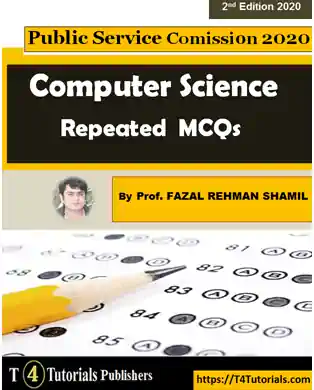1. instructions fetched by CPU according to the value of —— from memory?
A. program status word
B. status register
C. program counter
D. instruction register
E. both a and b
F. None of these
Answer C
2. —– is called a memory buffer and it is used to contain a speed differential
A. cache
B. accumulator
C. disk buffer
D. stack pointer
E. both a and b
F. None of these
Answer A
3. the address generated by CPU is:
A. absolute address
B. logical address
C. physical address
D. mac address
E. both a and b
F. None of these
Answer B
4. Which of the following option is true for virtual to physical address run-time mapping?
A. CPU
B. Operating system
C. memory management unit
D. PCI
E. both a and b
F. None of these
Answer C
5. —— is used to point the address of a page table in memory.
A. page register
B. program counter
C. stack pointer
D. page table base register
E. both a and b
F. None of these
Answer C
SET 2: Memory Management Mcqs
6. ——– Address is always deal with the program.
A. absolute
B. relative
C. logical
D. physical
E. both a and b
F. None of these
Answer C
7. ——- is contained by the page table.
A. page size
B. base address of every page
C. page offset
D. Page
E. both a and b
F. None of these
Answer B
8.for ——– the page table is maintained by the Operating System.
A. each instruction
B. each process
C. each thread
D. each address
E. both a and b
F. None of these
Answer B
9. The operating system is in?
A. high memory
B. System bus
C. either a or d (depending on the location of interrupt vector)
D. low memory
E. both a and b
F. None of these
Answer C
10. relocation register are used to :
A. a different address space to processes
B. providing less address space to processes
C. to protect the address spaces of processes
D. providing more address space to processes
E. both a and b
F. None of these
Answer C
SET 3: Memory Management Mcqs
11. With limit registers and relocation, each logical address must be _______ the limit register.
A. Not equal to
B. equal to
C. greater than
D. less than
E. both b and c
F. None of these
Answer D
12. The code that ——- is Transient operating system code.
A. stays in the memory always B. comes and goes as needed
C. never enters the memory space
D. is not easily accessible
E. both a and b
F. None of these
Answer D
13. the size of the operating system during program execution is ——— while using transient code.
A. changed
B. increased
C. maintained
D. decreased
E. both a, b and c
F. None of these
Answer A
14. Each partition may contain ________ when memory is divided into several fixed sized partitions.
A. multiple processes at once
B. exactly one process
C. Two process
D. at least one process
E. both a and b
F. None of these
Answer B
15. the degree of multiprogramming is bounded to which extent In fixed-sized partition?
A. All of these
B. the memory size
C. the CPU utilization
D. the number of partitions
E. both a and b
F. None of these
Answer D
SET 3: Memory Management Mcqs
16. The strategies like the first fit, best fit and worst fit are used to select a ______.
A. process from a queue to put in storage
B. process from a queue to put in memory
C. processor to run the next process
D. free hole from a set of available holes
E. both c and b
F. None of these
Answer D
17. The number of ——- can be granted by the Owner of address space.
A. Computers
B. Modules
C. Pages
D. Devices
E. both c and b
F. None of these
Answer C
18. To load and store the system data from memory ——- is used.
A. register
B. RAM
C. ROM
D. Buses
E. both c and b
F. None of these
Answer A
19. The stack pointer is a register that points to the:
A. Push of the stack
B. Bottom of the stack
C.Top of the stack
D. Pop of the stack
E. both a and b
F. None of these
Answer C
20. To read the———— I/O instruction transfer is used.
A. Information
B. Instructions
C. Description
D. Data
E. both c and b
F. None of these
Answer D
Next Operating System MCQs
- Operating System MCQs
- Operating System Multiple Choice Questions
- Operating Systems OS MCQs-Important
- File system Interface MCQS Questions Answers in Operating Systems
- Virtual Memory MCQS Questions Answers in Operating Systems
- Operating System Structures MCQs
- Process Synchronization Solved MCQs Questions Answers
- Deadlock MCQs Questions Answers
- Memory Management MCQs Questions Answers
- Unix Operating system solved MCQ’s Questions Answers
- Primary Memory Solved MCQs Questions Answers
- Linux process Management MCQs – Solved
- Linux File Permissions Solved MCQs
- Linux Startup and Shutdown MCQs
- Linux File Permissions MCQs Questions Answers
- Linux process Management MCQs – Solved
- Process Synchronization Solved MCQs Questions Answers
- Operating System Structures MCQs
- CPU Scheduling Solved MCQ’s Questions Answers
- Deadlock MCQs Questions Answers
- Memory Management MCQs Questions Answers
- File system Interface MCQS Questions Answers in Operating Systems
- Virtual Memory MCQS Questions Answers in Operating Systems
- Operating System Multiple Choice Questions Answers
